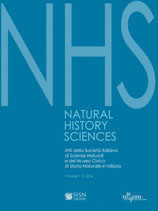Articles
1 September 2012
Vol. 153 No. 2 (2012)
Naticid gastropod and octopodid cephalopod predatory traces: evidence of drill holes on the leucosid crab Ristoria pliocaenica (Ristori, 1891), from the Pliocene of the “La Serra” quarry (Tuscany, Italy)

Publisher's note
All claims expressed in this article are solely those of the authors and do not necessarily represent those of their affiliated organizations, or those of the publisher, the editors and the reviewers. Any product that may be evaluated in this article or claim that may be made by its manufacturer is not guaranteed or endorsed by the publisher.
All claims expressed in this article are solely those of the authors and do not necessarily represent those of their affiliated organizations, or those of the publisher, the editors and the reviewers. Any product that may be evaluated in this article or claim that may be made by its manufacturer is not guaranteed or endorsed by the publisher.
834
Views
1217
Downloads










